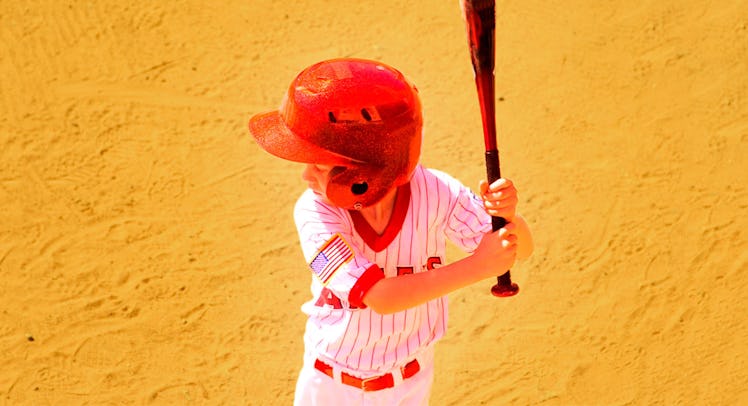How to Teach a Left-Handed Kid to Play Baseball
A top Little League coach shares his tips for guiding young Southpaws.

Playing baseball as a left-hander is, surprisingly, a pretty sweet gig. Lefties have a few definite advantages, such as a shorter right-field fence and a better body position for playing first base. Left-handed batters have a much clearer view of a ball from a right-handed pitcher, and lefties on the mound are decidedly much harder to steal off of, as they face runner on first base. In fact, the percentage of Southpaws playing baseball far exceeds the percentage of lefties in the actual population (25 to 10 percent according to some stats).
Still, it’s hard for kids who throw left-handed to learn some aspects of the game. The vast majority of players are right-handed, and the shape of the infield means that left-handed players have to throw awkwardly to their weak side to get an out at first base. As a result, they’re often relegated to certain positions on the field. But that doesn’t have to be the case. Just because some parts of the game are trickier to learn doesn’t mean there aren’t tips Little League coaches can follow to help ensure a young southpaw on the squad isn’t get shortchanged.
And to get some of those pointers, Fatherly reached out to Mike Randazzo, a left-handed former college player at Seton Hall and the coach of one of the best Little League teams in the country in Fairfield, Connecticut. Here are some of his strategies to keep in mind when teaching a lefty to play baseball.
Don’t Pigeonhole Them Too Early
Usually, left-handed players end up in one of three positions: Pitcher, first base, or outfield. But when you’re trying to teach a kid to play baseball, they’re going to want to do more than just stand on first base all day. Baseball is a sport of repetition, and when kids are learning, they need to get as many gloves on the ball as possible. Randazzo says that up until the most senior leagues of Little League, around the ages of 10, 11, and 12, he pretty much lets lefties play wherever. “Just put the boys on the field,” Randazzo said. “Rotate them into different positions so they don’t just get stale or bored.”
Sure, the throw from short to first is going to be a bit tough for a lefty, but it’s not impossible, especially at that level. What’s more important is getting kids comfortable fielding and playing a position. And depending on the athleticism of the player involved, Randazzo said it can definitely work out for a while.
Work on a Quick Pivot
If you have a left-handed player who wants to play third base or shortstop, it’s important that they practice their footwork. While you should teach fielding a ground ball much as you would to any young player, it’s critical for a leftie to be able to pivot quickly to make up for being positioned against the flow of play. It’s not easy, but the faster they can pivot their right leg forward and release the ball, the better chance they’ll have of nailing the runner at first. If they don’t learn how to properly set and pivot, they’ll end up throwing mostly with their arm and won’t get the body behind the throw. Also, southpaw shortstops are going to need a lot of additional practice covering second base on stolen bases. The player’s glove hand has to come across the body to make a backhanded tag (very tricky), or they have to somehow shuffle past the base in time to make the tag ⏤ almost, if not, impossible.
Play to Their Strengths
Once a player gets to around age 12, however, “reality starts to sink in” says Randazzo. It’s just highly unlikely that a left-handed player, no matter how athletic or how much work they put in, can pull off playing the left side of the infield (moving against the flow of play) in more competitive leagues. He used to joke with his eldest son (now on his way to a D1 college to pitch), who wasn’t the tallest of guys: “Your mother’s five foot nothing, I’m five foot eight: Don’t stop at the infield, go straight to the outfield. You’re too short for first base.” Lefties who hit that weedy puberty spurt can find a home at first base, where their glove side and lanky height can make them a great asset for making plays at the bag. Otherwise, lefties are perfectly capable of playing any of the outfield positions: at that distance, your throwing arm side doesn’t matter as much. And pitching is always going to be an option: some of the greatest pitchers in baseball right now, such as Dodgers ace Clayton Kershaw and Giants World Series MVP Madison Bumgarner are lefties.
Teach Hitting the Same
Hitting, as a left-hander, can be intimidating. Right-handed pitchers will be throwing pitches that often move across the plate toward the hitter. But Randazzo says you should teach hitting pretty much the same. Instead of teaching his boys (one is right-handed, but they both bat leftie) to try to turn on the ball too much, he instead focuses on contact hitting to the opposite field. If they’re slapping balls out to left center (or right-center for a right-handed hitter), he’s happy. “We want them to drive the ball that way, not pull the ball.” That keeps their feet and weight behind the ball and stops them from stepping out of the batters’ box.
This article was originally published on